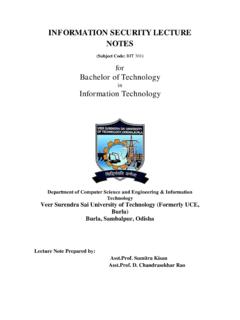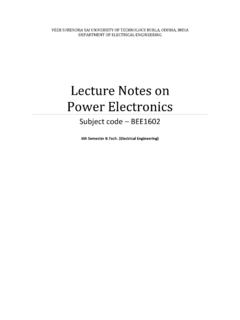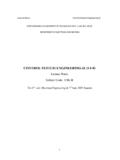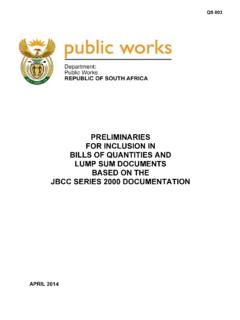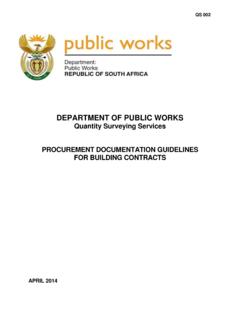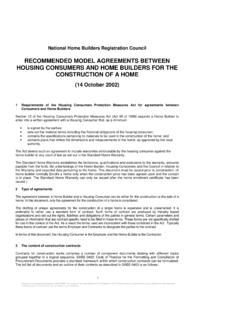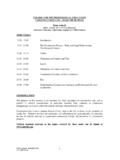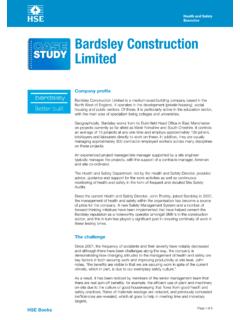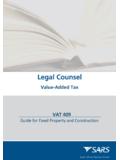Transcription of LECTURE NOTE COURSE CODE- BCE 206 …
1 Under revision LECTURE NOTE COURSE code - BCE 206 engineering surveying Under revision BCE206-ENGG. surveying (3-1-0) CR-04 Module I (10 Hrs) 1. Concept of surveying - Definition of surveying , Classification, Principle, Accuracy 2. Linear Measurement- Different methods of direct measurement instrument for chaining, Ranging, Chaining on uneven slopping ground, Errors in Chaining, Corrections. 3. Chain surveying Chain triangulation, Survey stn., lines, locating ground features, field work, instruments for setting out basic problems in chaining, obstacles in chaining Module II (10 Hrs) 4.
2 Compass surveying Principles use of Prismatic Compass, Measurement of bearings, Conversion of bearings, Local attraction, Correction of compass traverse. 5. Plane Table Survey- Principles, Advantages and disadvantages, Equipment, Accessories and their uses. Methods of plane table survey. Two point and three point problems. Module III (10 Hrs) 6. Levelling- Types of levelling and their uses, Permanent adjustment, Curvature and refraction effects. 7. Contouring-Characteristics and uses of contours. Methods of contouring. Module IV (10 Hrs) 8. Theodolite Survey Application in Height and distance measurements. Permanent adjustment of transit theodolite, methods of repetitions and reiterations. 9. Curve Setting Simple circular curve setting by chain, tape & theodolite 10. Minor Survey Instruments Box-sextant, Planimeter, Pantagraph, their working principles and uses.
3 Reference Books: 1. surveying & Levelling Kanetkar & Kulkarni, , Pune Vidyarthi Griha Prakashan. 2. surveying Punmia, Vol. I, Laxmi Publication. 3. surveying Duggal, Tata McGraw Hill Under revision Disclaimer This document does not claim any originality and cannot be used as a substitute for prescribed textbooks. The information presented here is merely a collection by the committee members for their respective teaching assignments. We would like to acknowledge various sources like freely available materials from internet from which the LECTURE note was prepared. The ownership of the information lies with the respective authors or institutions. Further, this document is not intended to be used for commercial purpose and the committee members are not accountable for any issues, legal or otherwise, arising out of use of this document.
4 The committee members make no representations or warranties with respect to the accuracy or completeness of the contents of this document and specifically disclaim any implied warranties of merchantability or fitness for a particular purpose. Under revision LECTURE 1 Introduction: surveying is defined as taking a general view of, by observation and measurement determining the boundaries, size, position, quantity, condition, value etc. of land, estates, building, farms mines etc. and finally presenting the survey data in a suitable form . This covers the work of the valuation surveyor, the quantity surveyor, the building surveyor, the mining surveyor and so forth, as well as the land surveyor.
5 Another school of thought define surveying as the act of making measurement of the relative position of natural and manmade features on earth s surface and the presentation of this information either graphically or numerically. The process of surveying is therefore in three stages namely: (i) Taking a general view This part of the definition is important as it indicates the need to obtain an overall picture of what is required before any type of survey work is undertaken. In land surveying , this is achieved during the reconnaissance study. (ii) Observation and Measurement This part of the definition denotes the next stage of any survey, which in land surveying constitutes the measurement to determine the relative position and sizes of natural and artificial features on the land. (iii) Presentation of Data: The data collected in any survey must be presented in a form which allows the information to be clearly interpreted and understood by others.
6 This presentation may take the form of written report, bills of quantities, datasheets, drawings and in land surveying maps and plan showing the features on the land. Types of surveying On the basis of whether the curvature of the earth is taken into account or not, surveying can be divided into two main categories: Plane surveying : is the type of surveying where the mean surface of the earth is considered as a plane. All angles are considered to be plane angles. For small areas less than 250 km2 plane surveying can safely be used. For most engineering projects such as canal, railway, highway, building, pipeline, etc constructions, this type of surveying is used. It is worth noting that the difference between an arc distance of km and the subtended chord lying in the earth s surface is 7mm. Also the sum of the angles of a plane triangle and the sum of the angles in a spherical triangle differ by 1 second for a triangle on the earth s surface having an area of 196 km2.
7 Under revision Geodetic surveying : is that branch of surveying , which takes into account the true shape of the earth (spheroid). Classification of surveying Introduction For easy understanding of surveying and the various components of the subject, we need a deep understanding of the various ways of classifying it. Objective To enable the students have understanding of the various ways of classifying surveying Classification Of surveying surveying is classified based on various criteria including the instruments used, purpose, the area surveyed and the method used. Classification on the Basis of Instruments Used. Based on the instrument used; surveys can be classified into; i) Chain tape surveys ii) Compass surveys iii) Plane table surveys iv) Theodelite surveys Classification based on the surface and the area surveyed i) Land survey Land surveys are done for objects on the surface of the earth.
8 It can be subdivided into: (a) Topographic survey: This is for depicting the (hills, valleys, mountains, rivers, etc) and manmade features (roads, houses, ) on the surface of the earth. (b) Cadastral survey is used to determining property boundaries including those of fields, houses, plots of land, etc. (c) engineering survey is used to acquire the required data for the planning, design and Execution of engineering projects like roads, bridges, canals, dams, railways, buildings, etc. Under revision (d) City surveys: The surveys involving the construction and development of towns including roads, drainage, water supply, sewage street network, etc, are generally referred to as city survey. (2) Marine or Hydrographic Survey: Those are surveys of large water bodies for navigation, tidal monitoring, the construction of harbours etc.
9 (3) Astronomical Survey: Astronomical survey uses the observations of the heavenly bodies (sun, moon, stars etc) to fix the absolute locations of places on the surface of the earth. Under revision LECTURE 2 CLASSIFICATION ON THE BASIS OF PURPOSE i) engineering survey ii) Control Survey: Control survey uses geodetic methods to establish widely spaced vertical and horizontal control points. iii) Geological Survey Geological survey is used to determine the structure and arrangement of rock strata. Generally, it enables to know the composition of the earth. iv) Military or Defence Survey is carried out to map places of military and strategic importance iv) Archeological survey is carried out to discover and map ancient/relies of antiquity. Classification Based On Instrument Used i.
10 Chain/Tape Survey: This is the simple method of taking the linear measurement using a chain or tape with no angular measurements made. ii. Compass Survey: Here horizontal angular measurements are made using magnetic compass with the linear measurements made using the chain or tape. iii. Plane table survey: This is a quick survey carried out in the field with the measurements and drawings made at the same time using a plane table. iv. Leveling This is the measurement and mapping of the relative heights of points on the earth s surface showing them in maps, plane and charts as vertical sections or with conventional symbols. Vi. Theodolite Survey: Theodolite survey takes vertical and horizontal angles in order to establish controls CLASSIFICATION BASED ON THE METHOD USED 1. Triangulation Survey In order to make the survey, manageable, the area to be surveyed is first covered with series of triangles. Lines are first run round the perimeter of the plot, then the details Under revision fixed in relation to the established lines.
